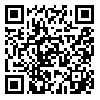Volume 9 -
MEJDS (2019) 9: 27 |
Back to browse issues page
Download citation:
BibTeX | RIS | EndNote | Medlars | ProCite | Reference Manager | RefWorks
Send citation to:



BibTeX | RIS | EndNote | Medlars | ProCite | Reference Manager | RefWorks
Send citation to:
Hosseinlu A, Esma’ili M, Kazemian S. Life Experience of Blind People: Recognize their Driving Patterns. MEJDS 2019; 9 :27-27
URL: http://jdisabilstud.org/article-1-1022-en.html
URL: http://jdisabilstud.org/article-1-1022-en.html
1- Allameh Tabataba'i University
Abstract: (2509 Views)
Background & Objective: Having a different physical and emotional experience, including stressors in human life, could affect individual identities, psychosocial dimensions, emotional balance, self–satisfaction, sense of competence and achievement, social interactions, interpersonal relationships and individual needs adaptability. Blindness is a different experience. Blind people usually have difficulties in adaptation with their environment because they lose their basic sense of mobility and navigation skills. However, it is said that a person with a behavioral pattern can achieve success when a person can navigate his work and his personal life. Identifying behavioral patterns of individuals can lead to the correct design of the movement for successful relationships and constructive interaction with others to obtain the desired outcomes from work negotiations, family relationships and friendly communication. Therefore, the present study was conducted to examine the life experience of blind people to recognize their driving patterns.
Methods: This research was a qualitative study and phenomenological research. The sample and statistical population of the study were blind subjects with 22 years and older in Tehran. The people were selected using targeted sampling method, and the data–gathering tool was semi–structured interviews. In analyzing the data obtained from the interview, two methods of descriptive phenomenological analysis (Clayzee method) and the coding method used simultaneously. Interview data at the same time and after completing interviews and recording the main points during the session, the participants 'statements repeatedly listened to the recorded notes, and their statements word–of–word wrote on paper and several times studied to understand participants' feelings and experiences.
Results: Analysis of interviews data about the living experience of blind people to determine the characteristics of their driving patterns had 21 major categories. They include: normalization in the course of time, the color of divinity, the relationship with God and Holliman’s, the blessings of God, strong self–concept and self–reliance, self–belief, strong will, sense of usefulness, positive effects, emphasis on self–help, help–seeking and consulting with others, communication with others, communication with the blind, community support, family support, friendship support, welcoming culture, hindering others, negative impacts, education, financial dependence, outcomes and livelihood status obtained. Ultimately identified five core categories :as char:acteristics of the driving patterns of blind people, including overtime adaptation, association with God, social skills, individual support factors and social support.
Conclusion: Characteristics of the driving patterns of blind people were a set of interpersonal and interpersonal features and factors such as environmental factors and, most important, communication with the creator of being. Therefore, it seems that neglecting or ignoring any of these factors and features can deprive an individual of having driving patterns.
Methods: This research was a qualitative study and phenomenological research. The sample and statistical population of the study were blind subjects with 22 years and older in Tehran. The people were selected using targeted sampling method, and the data–gathering tool was semi–structured interviews. In analyzing the data obtained from the interview, two methods of descriptive phenomenological analysis (Clayzee method) and the coding method used simultaneously. Interview data at the same time and after completing interviews and recording the main points during the session, the participants 'statements repeatedly listened to the recorded notes, and their statements word–of–word wrote on paper and several times studied to understand participants' feelings and experiences.
Results: Analysis of interviews data about the living experience of blind people to determine the characteristics of their driving patterns had 21 major categories. They include: normalization in the course of time, the color of divinity, the relationship with God and Holliman’s, the blessings of God, strong self–concept and self–reliance, self–belief, strong will, sense of usefulness, positive effects, emphasis on self–help, help–seeking and consulting with others, communication with others, communication with the blind, community support, family support, friendship support, welcoming culture, hindering others, negative impacts, education, financial dependence, outcomes and livelihood status obtained. Ultimately identified five core categories :as char:acteristics of the driving patterns of blind people, including overtime adaptation, association with God, social skills, individual support factors and social support.
Conclusion: Characteristics of the driving patterns of blind people were a set of interpersonal and interpersonal features and factors such as environmental factors and, most important, communication with the creator of being. Therefore, it seems that neglecting or ignoring any of these factors and features can deprive an individual of having driving patterns.
Type of Study: Original Research Article |
Subject:
Rehabilitation
Send email to the article author
| Rights and permissions | |
 |
This work is licensed under a Creative Commons Attribution-NonCommercial 4.0 International License. |




